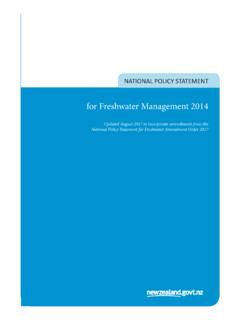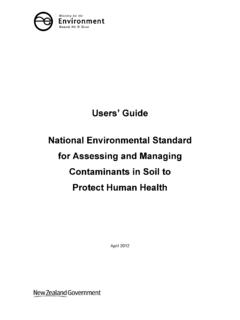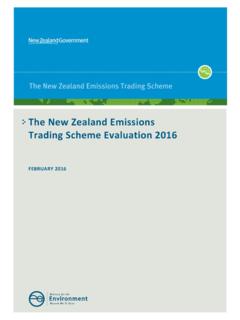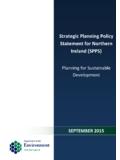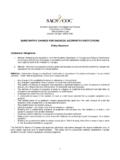Transcription of on Urban Development Capacity 2016 - Ministry …
1 NATIONAL policy STATEMENT. on Urban Development Capacity 2016 . Contents Preamble 3. Title 6. Commencement 6. Interpretation 6. National significance 9. Objectives 10. Policies 11. Timeframes to implement this National policy Statement 17. Review of this National policy Statement 18. 2. Preamble New Zealand is highly urbanised, with 73 percent of us living in Urban areas of at least 30,000. Urban environments are characterised by the closeness of people and places, and the connections between them. They enable us to live, work and play in close proximity, giving us access to amenity, services and activities that people value. While Urban environments share these common characteristics, they also have unique local variations; the traits that make one Urban environment different from another. Urban environments often have high rates of population and economic growth. Reflecting this, they are dynamic, and are constantly changing to reflect the needs of their communities.
2 This constant change can have both positive and negative impacts: well-functioning Urban areas maximise the positives and minimise the negatives. Well-functioning Urban environments provide for people and communities' wellbeing. They provide people with access to a choice of homes and opportunities to earn income, good connections between them, and attractive built and natural environments. They have good quality physical and social infrastructure and open space. They make efficient use of resources and allow land uses to change to meet the changing needs of their inhabitants while protecting what is precious. They make the most of their ability to connect to other parts of the world through trade and the movement of goods and people. Such Urban environments attract people and investment, and are dynamic places that make a significant contribution to national economic performance. Local authorities play an important role in shaping the success of our cities by planning for growth and change and providing critical infrastructure.
3 Ideally, Urban planning should enable people and communities to provide for their social, economic, cultural and environmental wellbeing through Development , while managing its effects. This is a challenging role, because cities are complex places; they develop as a result of numerous individual decisions, and this often involves conflict between diverse preferences. This national policy statement provides direction to decision-makers under the Resource Management Act 1991 (RMA) on planning for Urban environments. It recognises the national significance of well-functioning Urban environments, with particular focus on ensuring that local authorities, through their planning, both: enable Urban environments to grow and change in response to the changing needs of the communities, and future generations; and provide enough space for their populations to happily live and work. This can be both through allowing Development to go up by intensifying existing Urban areas, and out.
4 By releasing land in greenfield areas. This national policy statement covers Development Capacity for both housing and business, to recognise that mobility and connectivity between both are important to achieving well-functioning Urban environments. Planning should promote accessibility and connectivity between housing and businesses. It is up to local authorities to make decisions about what sort of Urban form to pursue. This national policy statement aims to ensure that planning decisions enable the supply of housing needed to meet demand. This will contribute to minimising artificially inflated house prices at all According to Statistics New Zealand's most recent estimates. 1. 3. levels and contribute to housing affordability overall. Currently, artificially inflated house prices drive inequality, increase the fiscal burden of housing-related government subsidies, and pose a risk to the national economy. Local authorities need to provide for the wellbeing of current generations, and they must also provide for the wellbeing of the generations to come.
5 The overarching theme running through this national policy statement is that planning decisions must actively enable Development in Urban environments, and do that in a way that maximises wellbeing now and in the future. This national policy statement does not anticipate Development occurring with disregard to its effect. Local authorities will still need to consider a range of matters in deciding where and how Development is to occur, including the direction provided by this national policy statement. Competition is important for land and Development markets because supply will meet demand at a lower price when there is competition. There are several key features of a competitive land and Development market. These include providing plenty of opportunities for Development . Planning can impact on the competitiveness of the market by reducing overall opportunities for Development and restricting Development rights to only a few landowners.
6 This national policy statement requires councils to provide in their plans enough Development Capacity to ensure that demand can be met. This includes both the total aggregate demand for housing and business land, and also the demand for different types, sizes and locations. This Development Capacity must also be commercially feasible to develop, and plentiful enough to recognise that not all feasible Development opportunities will be taken up. This will provide communities with more choice, at lower prices. Development Capacity must be provided for in plans and also supported by infrastructure. Urban Development is dependent on infrastructure, and decisions about infrastructure can shape Urban Development . This national policy statement requires Development Capacity to be serviced with Development infrastructure, with different expectations from this infrastructure in the short, medium and long-term. It encourages integration and coordination of land use and infrastructure planning.
7 This will require a sustained effort from local authorities, council- controlled organisations, and infrastructure providers (including central government) to align their intentions and resources. Another key theme running through the national policy statement is for planning to occur with a better understanding of land and Development markets, and in particular the impact that planning has on these. This national policy statement requires local authorities to prepare a housing and business Development Capacity assessment and to regularly monitor market indicators, including price signals, to ensure there is sufficient Development Capacity to meet demand. Local authorities must respond to this information. If it shows that more Development Capacity needs to be provided to meet demand, local authorities must then do so. Providing a greater number of opportunities for Development that are commercially feasible will lead to more competition among developers and landowners to meet demand.
8 This national policy statement also places a strong emphasis on planning coherently across Urban housing and labour markets, which may cross local authority administrative boundaries. This will require coordinated planning between local authorities that share jurisdiction over Urban housing and labour markets. This includes collaboration between regional councils and territorial authorities who have differing functions under the RMA, but which all impact on and are impacted on by Urban Development . 4. This national policy statement recognises that the benefits of the statement are greatest in Urban areas experiencing the highest levels of growth. It takes a tiered approach to the application of policies using the Statistics New Zealand Urban areas classification, and population projections to target different policies to different local authorities. This classification also informs local authorities that they must work together.
9 The boundaries of the Urban areas do not restrict the area in which the local authorities apply the policies. Local authorities that have a high-growth Urban area within their jurisdiction are expected to meet all of the requirements of policies in this national policy statement, while local authorities with medium-growth Urban areas in their jurisdiction, and all other local authorities, have lesser requirements, as per the table below. Local authorities that Local authorities that have a medium-growth have a high-growth Urban All local authorities Urban area within their area within their district district or region or region Objectives that All All All apply Policies that PA1 - PA4 PA1 - PA4 PA1 - PA4. apply PB1 - PB7 PB1 - PB7. PC1 - PC4 PC1 - PC4. PD1 - PD2 PD1 - PD2. PC5 - PC14. PD3 - PD4. This preamble may assist the interpretation of the national policy statement. 5. Title This national policy statement is the National policy Statement on Urban Development Capacity 2016 .
10 Commencement This national policy statement comes into force on the 28th day after the date on which it is notified in the New Zealand Gazette. Interpretation In this national policy statement, unless the context otherwise requires, . Act means the Resource Management Act 1991. Business land means land that is zoned for business uses in Urban environments, including but not limited to land in the following examples of zones: industrial commercial retail business and business parks centres (to the extent that this zone allows business uses). mixed use (to the extent that this zone allows business uses). Decision-maker means any person exercising functions and powers under the Act. Demand means: In relation to housing, the demand for dwellings in an Urban environment in the short, medium and long-term, including: a) the total number of dwellings required to meet projected household growth and projected visitor accommodation growth.
